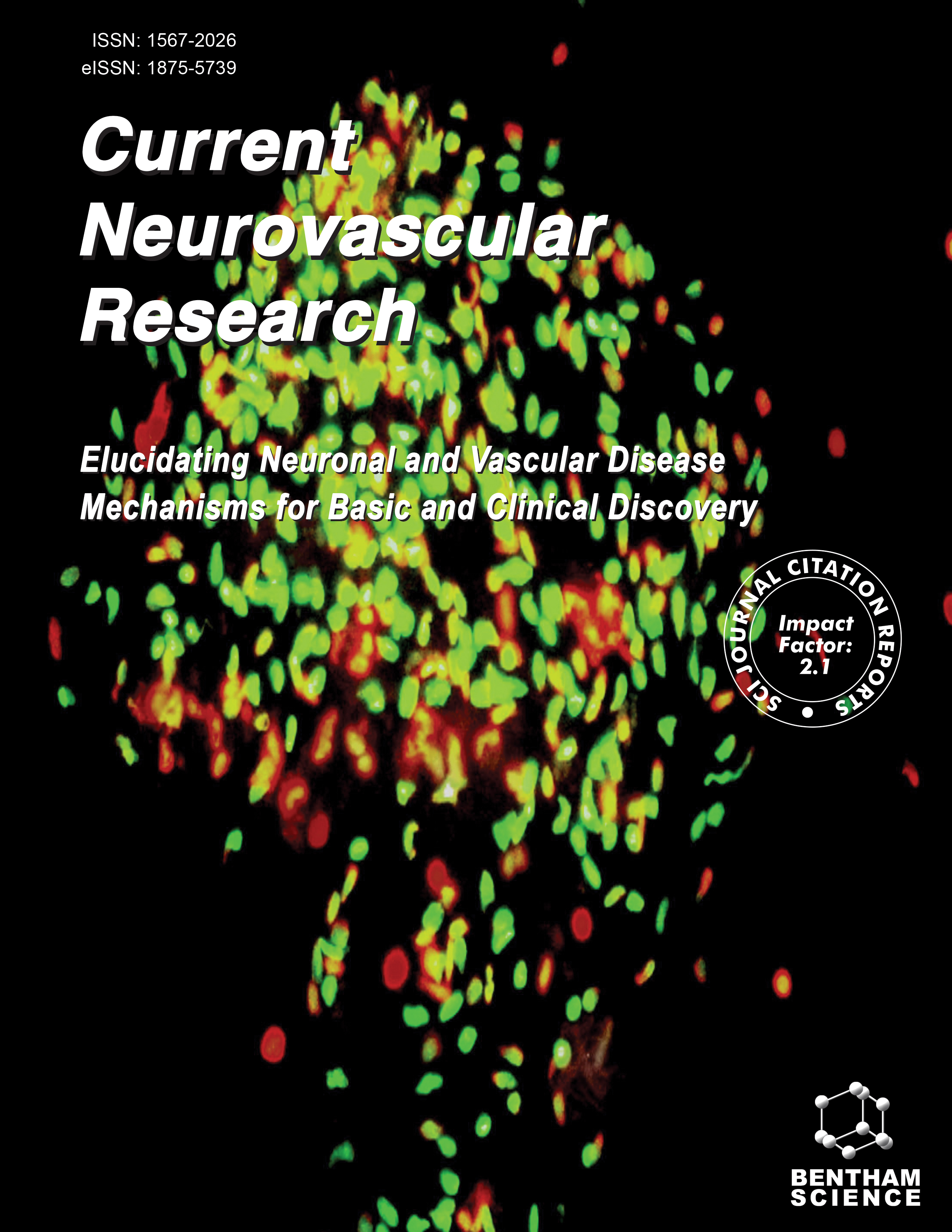- Home
- A-Z Publications
- Current Neurovascular Research
- Previous Issues
- Volume 12, Issue 3, 2015
Current Neurovascular Research - Volume 12, Issue 3, 2015
Volume 12, Issue 3, 2015
-
-
Differential Regulation of microRNAs in Patients with Ischemic Stroke
More LessAuthors: Sheng-Hua Li, Sheng-You Su and Jing-Li LiuMicroRNAs have been discovered as regulators of gene expression and thus their potential in clinical disease diagnostics, prognosis and therapy is being actively pursued. MicroRNAs play an important role in atherosclerosis-related diseases, such as cerebrovascular and cardiovascular disease. However, the effect of miR-185 and miR-146a on patients with ischemic stroke (IS) in the different phases has not been reported. In this Read More
-
-
-
Combination of Local Transplantation of In Vitro Bone-marrow Stromal Cells and Pulsed Electromagnetic Fields Accelerate Functional Recovery of Transected Sciatic Nerve Regeneration: A Novel Approach in Transected Nerve Repair
More LessAuthors: Rahim Mohammadi and Sirvan MahmoodzadehEffect of combination of undifferentiated bone marrow stromal cells (BMSCs) and pulsed electromagnetic fields (PEMF) on transected sciatic nerve regeneration was assessed in rats. A 10 mm nerve segment was excised and a vein graft was used to bridge the gap. Twenty microliter undifferentiated BMSCs (2x 107 cells /mL) were administered into the graft inBMSC group with no exposure to PEMF. In BMSC/PEMF grou Read More
-
-
-
Radix Angelica Sinensis Promotes Synaptic Plasticity During Cognitive Recovery in Chronically Stressed Rats
More LessAuthors: Min Deng, Huimin Sun, Jun Shen, Yuanteng Fan, Lei Zhang and Junjian ZhangThe accumulation of chronic stress is associated with cognitive dysfunction. Radix Angelica Sinensis (RAS) has been shown to have neuroprotective potential for treating Alzheimer's disease and vascular dementia. However, the impact of RAS on cognitive impairment induced by chronic stress has not been studied. In the present study, RAS significantly alleviated cognitive deficits in rats subjected to chronic restraint stress. This Read More
-
-
-
Neuroprotective Effects of Agomelatine and Vinpocetine Against Chronic Cerebral Hypoperfusion Induced Vascular Dementia
More LessAuthors: Surbhi Gupta, Prabhat Singh, Brij Mohan Sharma and Bhupesh SharmaChronic cerebral hypoperfusion (CCH) has been considered as a critical cause for the development of cognitive decline and dementia of vascular origin. Melatonin receptors have been reported to be beneficial in improving memory deterioration. Phosphodiesterase-1 (PDE1) enzyme offers protection against cognitive impairments and cerebrovascular disorders. Aim of this study is to explore the role of agomelatine (a dual Read More
-
-
-
Interleukin-1β Receptor Antagonism Prevents Cognitive Impairment Following Experimental Bacterial Meningitis
More LessPneumococcal meningitis is characterized by high rates of mortality and long-term cognitive impairment. In this study, we evaluated the effects of interleukin (IL)-1β receptor antagonist (IL-1Ra) on memory, cytokine, and brainderived neurotrophic factor (BDNF) levels in hippocampus after experimental pneumococcal meningitis. In a first experiment the animals were divided into four groups: control/saline, control treated w Read More
-
-
-
Rufinamide Improves Functional and Behavioral Deficits via Blockade of Tetrodotoxin-Resistant Sodium Channels in Diabetic Neuropathy
More LessAuthors: Shivsharan B. Kharatmal, Jitendra N. Singh and Shyam S. SharmaRufinamide is a structurally novel, antiepileptic drug approved for the treatment of Lennox-Gastaut syndrome. Its mechanism of action involves inhibition of voltage-gated Na+ channels (VGSCs) with possible membrane-stabilizing effects. VGSCs play a significant role in the pathogenesis of neuropathic pain. Therefore, we investigated the effects of rufinamide on tetrodotoxin-resistant sodium current (TTX-R INa) in acutely di Read More
-
-
-
Outcome Prediction after Non-aneurysmal Non-traumatic Subarachnoid Hemorrhage
More LessContrary to aneurysmal bleeding, non-aneurysmal non-traumatic subarachnoid hemorrhage (NASAH) is rarely associated with unfavorable clinical outcome, cerebral infarction and vasospasm. We aimed to identify independent predictors for a poor clinical course and outcome after NASAH. All patients with NASAH treated at our institution between January 2005 and December 2012 were retrospectively analyzed. Collected dem Read More
-
-
-
Perfusion-diffusion Mismatch Predicts Early Neurological Deterioration in Anterior Circulation Infarction without Thrombolysis
More LessPerfusion-diffusion mismatch in magnetic resonance imaging (MRI) represents the non-core hypoperfused area in acute ischemic stroke. The mismatch has been used to predict clinical response after thrombolysis in acute ischemic stroke, but its role for predicting early neurological deterioration (END) in acute ischemic stroke without thrombolysis has not been clarified yet. In this study, we prospectively recruited 54 Read More
-
-
-
Acute and Chronic Treatments with Quetiapine Increase Mitochondrial Respiratory Chain Complex Activity in the Rat Brain
More LessSeveral studies have found that the molecular mechanisms of mitochondrial energy metabolism are impaired in major depressive disorder (MDD). Classic antidepressants and atypical antipsychotics can alter the function of enzymes involved in adenosine triphosphate (ATP) metabolism. Quetiapine is an atypical antipsychotic that, in addition to having a therapeutic benefit in treating MDD, appears to exert antioxidant and Read More
-
-
-
VEGF Signaling Regulates Cofilin and the Arp2/3-complex within the Axonal Growth Cone
More LessAuthors: Matthias Dumpich, Hans Georg Mannherz and Carsten TheissOver the last decade, our understanding of the vascular endothelial growth factor (VEGF) has rapidly increased, becoming the focus of many investigations the world over. Besides its classical role in the vascular system, VEGF was also identified as a factor affecting the nervous system. One structure that responds to VEGF-signaling is the axonal growth cone, the correct behavior of which is essential for the development Read More
-
Volumes & issues
-
Volume 21 (2024)
-
Volume 20 (2023)
-
Volume 19 (2022)
-
Volume 18 (2021)
-
Volume 17 (2020)
-
Volume 16 (2019)
-
Volume 15 (2018)
-
Volume 14 (2017)
-
Volume 13 (2016)
-
Volume 12 (2015)
-
Volume 11 (2014)
-
Volume 10 (2013)
-
Volume 9 (2012)
-
Volume 8 (2011)
-
Volume 7 (2010)
-
Volume 6 (2009)
-
Volume 5 (2008)
-
Volume 4 (2007)
-
Volume 3 (2006)
-
Volume 2 (2005)
-
Volume 1 (2004)
Most Read This Month
Article
content/journals/cnr
Journal
10
5
false
en


